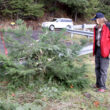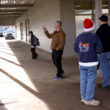Sean C. Morgan
Of The New Era
The city of Sweet Home is exploring the possibility of forming an urban renewal district to help fund downtown revitalization efforts.
The city is beginning a feasibility study, which is a precursor to establishing an urban renewal district and an overall plan and to determining if it is a viable funding mechanism for revitalizing the downtown area through the Sweet Home Active Revitalization Committee, City Manager Craig Martin said.
An urban renewal district captures property tax money derived from increasing assessed values within the district.
“The city looked at this in July 2003,” he said. “At the time, we were looking at it in anticipation of the proposed Salmon Run development.”
At that time, the city learned that property tax compression would reach $500,000 if an urban renewal district were formed, Martin said. This came around the same time as an overall decrease in utility property values, leaving a shortfall in police and library funding and making the formation of an urban renewal district impractical.
Property tax compression is tax revenue that jurisdictions lose for exceeding 1990’s Measure 5 property tax rate limitations on individual assessed property values. When applying compression, temporary levies, such as the police and library levies are reduced before permanent tax rates, such as the city or fire department.
Compression has eased since 2003, Martin said. “Fast forward to 2008, we’ve seen a lot of value added to the city collectively.”
A cursory evaluation of compression loss to the district is .6 to 1.7 percent of property taxes, Martin said. It will still increase compression, but it’s in a much more acceptable range, assuming property values hold.
The urban renewal district is one mechanism that could generate revenue to fund revitalization efforts, he said. It can be used for streetscape projects; improving public spaces; developing a town square concept; some rehab and redevelopment of property with low- or no-interest loans; and infrastructure improvements, to bring water, sewer and streets to standard, so businesses can develop.
While the district is in effect, taxing agencies do not receive the increases in property tax revenue, Martin said. The idea of the district is to plow the money back into the district, improving the area and significantly improving general property tax revenues after the district expires several years later.
Specific projects haven’t been identified yet, Martin said. During the process, Martin and SHARE members will look at specific ideas, streets and potential areas for improvement, including boundaries.
If the district is created, the city would borrow the funds to complete the projects, Martin said. The tax revenue generated by the resulting increases in property values is used to pay back the loans.
As Martin and the SHARE members develop ideas, consulting firm Tashman Johnson, LLC, will calculate the impact to local taxing districts and develop revenue projections.
“If we decide to move forward with urban renewal, then the council will have to make a decision whether to move forward,” Martin said, developing a more specific plan and holding public hearings.
It could potentially be created by fall, Martin said.
The SHARE planning and finance committees are primarily working with Martin on the district. Deciding whether to form a district is one of the SHARE organization’s goals.




